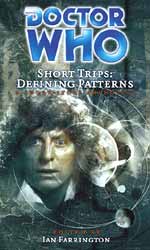|
Click here to return to the main site. Book Review
The known universe is home to countless trillions of lives, all interweaving with each other and affecting the line of history. When someone makes a decision, no matter how significant or seemingly irrelevant, they cause unknown effects throughout the ages. Everywhere he looks, the Doctor sees the same patterns - the same events, decisions and actions cropping up again and again. Look at the bigger picture, however, and maybe - just maybe - you’ll see how the universe works. But, as the Doctor and his companions discover, are these patterns really there? Are we all predetermined to follow a particular path? Do we reap what we sow or is it a case of what will be will be? Are coincidences really just that, or do we miss their deeper meanings? Do we, by the very nature of seeing these patterns, define them...? What a clever theme for a collection of short stories! Are patterns really there? Are coincidences really just that? This way, any unintentional repetition between the stories (such as perhaps the deterministic messages of both John Dorney’s “Lepidoptery for Beginners” and Ian Mond’s “The Book of My Life”) can be attributed to the anthology’s theme: “Ah, well, that’s a defining pattern, that is. Clever, eh?” Any stories that the reader can’t see as fitting in with the theme (for instance, the relevance of Stephen Hatcher’s “Closing the Account” and Lizzie Hopley’s “Stanley” is on very shaky ground) can be attributed to proof of the notion that patterns don’t really exist except so far as we imagine them. Several stories, such as “Machine Time” by George Ivanoff, “The Time and Tide” by Neil Corry and “One Card for the Curious” by Xanna Eve Chown, read like parts of a larger tapestry, in that some explanations and background details seem to be lacking. Both “Mutiny” by Robert Dick and “The Great Escapes” by Simon Guerrier are companion-oriented narratives (featuring Harry Sullivan and Lucie Miller respectively) that seem to stop before their respective stories have been resolved, in the latter case particularly so. Is this just an excuse to write and publish unfinished stories? At least “Machine Time” seems to have a connection with a subsequent narrative near the end of the book - or am I just imagining that pattern? Or am I missing the patterns that connect, explain and resolve all the above named stories? Conversely, I think Ian Briggs’s “The Celestial Harmony Engine” is impenetrable mainly by dint of its purple prose, while “Stanley” is just plain silly. The stories that really make this collection worth reading include Dave Owen’s “Numb”, a Third Doctor / Sarah tale that truly encapsulates the anthology’s themes and demonstrates them in an accessible manner; “Closing the Account”, an evocative conversation with the Seventh Doctor about how history remembers people; Steven Savile’s “Loose Change”, a simple but engaging tale of a coin’s journey and the very different lives of the people who briefly possess it; “Lepidoptery for Beginners”, a witty exploration of the butterfly effect in chaos theory; Chris Thomas’s “One Step Forward, Two Steps Back”, a tragic tale of interference in a planet’s history and the Doctor’s own timeline; and “Homework”, by short-story competition winner Michael Coen, an effective narrative written in the style of a schoolboy’s English assignment. The latter three stories all feature the Second Doctor - was I in a particularly Pat Troughton mood when I read them, or is their quality or my appreciation of them just a coincidence? However, my favourite tale in the collection is Mat Coward’s “Losing the Audience”. This features not only a well-characterised pre-Unearthly Child TARDIS crew of the First Doctor and Susan, but also a likable guest character in the form of a jaded 1950s radio comedian. The Doctor who appears most frequently in this collection is the Seventh, who clocks up no fewer than seven appearances. Coincidence? However, the only Doctor depicted on the cover is the Fourth. No pattern there, then. Defining Patterns is definitely a mixed bag - dare I say, a patchwork pattern? Maybe that’s why editor Ian Farrington chose the Sixth Doctor for his linking material. Make of it what you will. 5 Richard McGinlay |
|---|


